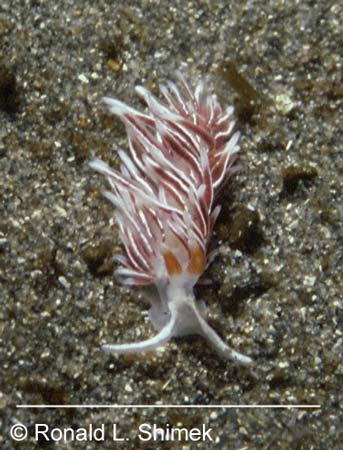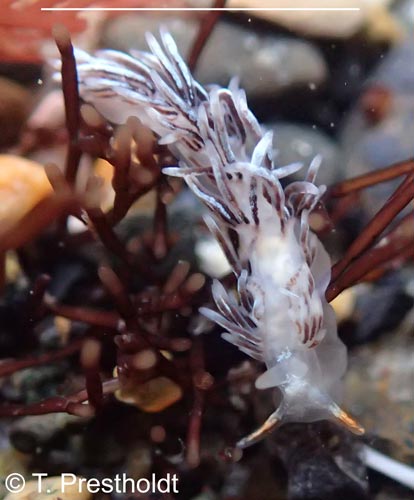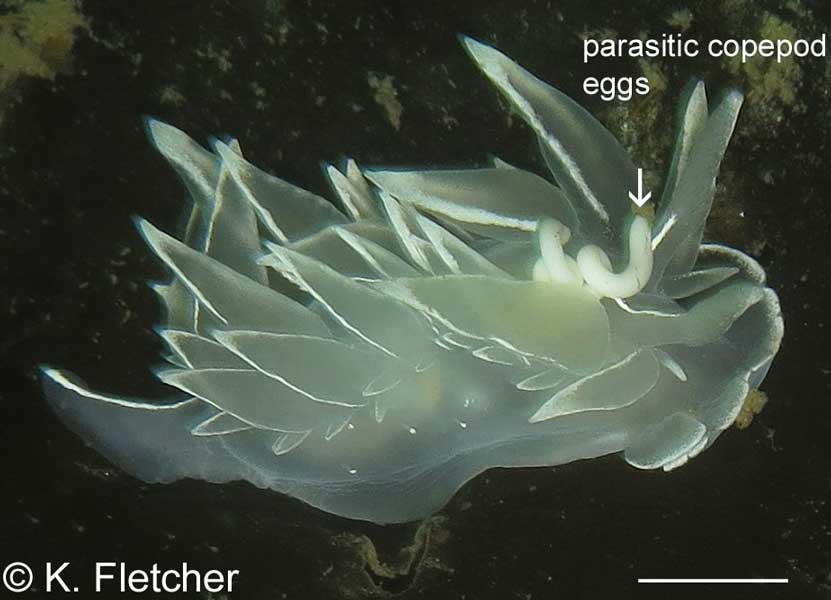Nudibranchs and other Sea Slugs
Order Nudibranchia - Suborder Cladobranchia
Superfamilies Fionoidea, Proctonotoidea & Tritonioidea
Abronicidae

Otter Crest, OR, intertidal
Cape Arago, OR, intertidal
Abronica abronia (MacFarland, 1966)
Graceful Aeolid
intertidal size to 15mm
northern Mexico to northern Washington
This
species is primarily intertidal but rare to see. It has a purple
band in the middle of the rhinophores. Its multicolored cerata
are tipped in yellow, greenish to brown in the middle and yellow to red
at the base.
(previous names - Cuthona abronia, Trinchesia abronia)
Cuthonellidae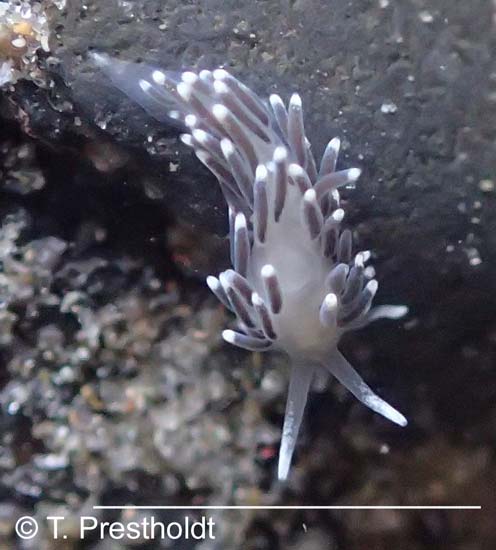
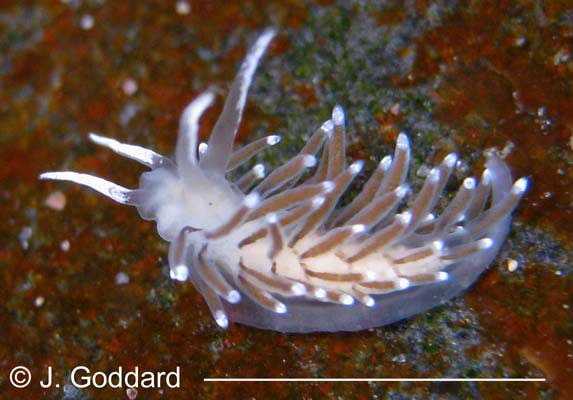
Bob Creek, OR, intertidal
Otter Crest, OR, intertidal
Cuthonella cocoachroma (Williams & Gosliner, 1979)Chocolate Aeolidintertidal size to 20mm
central California to northern Washington
The name comes from the brown color of the cerata which may be reddish to chocolate brown. It is very similar to C. concinna.
(previous name - Cuthona cocoachroma)
Petersburg, AK, intertidal
Sechelt
Inlet, BC, subtidal
Coryphella verrucosa (M. Sars, 1829)Red-gilled Nudibranchintertidal to 300m size to 10cmnorthern Washington to southern Alaska andcircumboreal, Sea of Japan and North AtlanticThis species is infrequently found intertidally.
(previous names - Flabellina verrucosa, Aeolidia verrucosa)
Coryphellidae

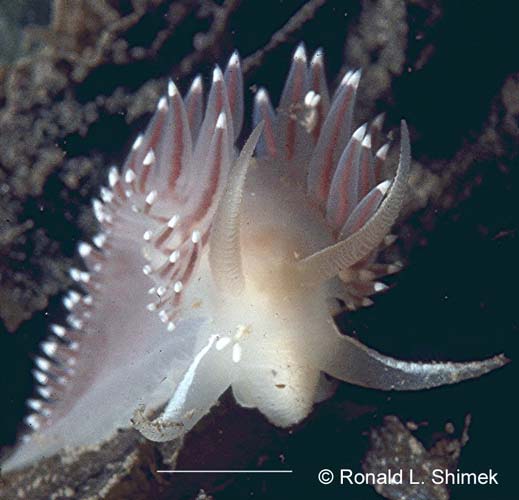
Maple Bay, BC, subtidal
Shilshoe Bay, WA, subtidal
Coryphella trophina (Bergh, 1890)Long-mouthed Aeolid
subtidal to 65m size to 50mm
central Oregon to southern Alaska; Sea of Japan
This species has a pronounced pointed snout and the cerata are
continuous along its back instead of in clusters.
(synonym - Flabellina trophina, Flabellina fusca, Coryphella fusca)
Turn Island, WA,
subtidal Freshwater Bay, WA Bainbridge Island, WA
subtidal
subtidal
Neah Bay, WA, subtidal, right one with eggs
Eubranchus rustyus (Er. Marcus, 1961)
Rusty Aeolid
intertidal to at least 20m size to 25mm
northern Mexico to Ketchikan, Alaska
This
little species is difficult to spot among the hydroids. The body
is white with yellow-white dots and some brownish colorations. The
cerata and rhinophores are tipped in white.
(previous name - Capellinia rustya)
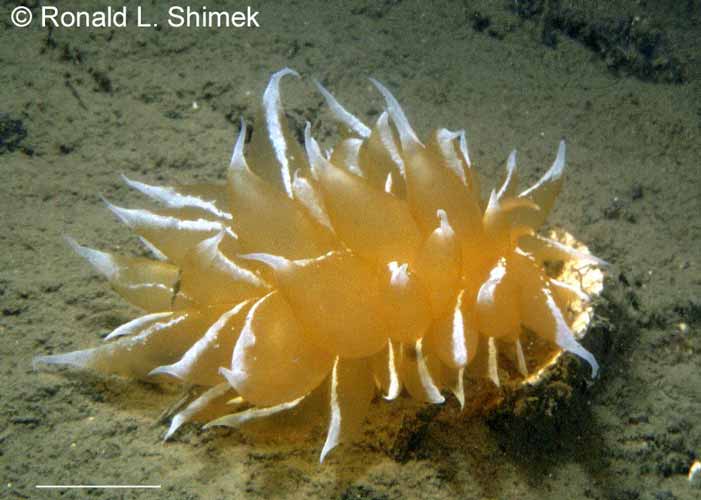

San Juan Islands, WA, subtidal
Bainbridge Island, WA, subtidal
Dirona pellucida Volodchenko, 1941Translucent Dironaintertidal to subtidal size to 12cmcentral Oregon to northern Alaska; Sea of Japan to RussiaThis is infrequently found intertidally. White speckling on the lower body distinquish it from D. albolineata.(synonym - Dirona aurantia)

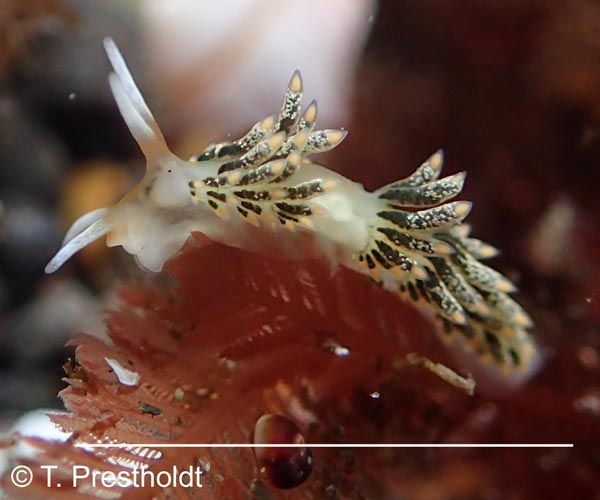 Drakes Estero, CA, intertidalDiaphoreolis flavovulta (MacFarland, 1966)Yellowhead Aeolid
Drakes Estero, CA, intertidalDiaphoreolis flavovulta (MacFarland, 1966)Yellowhead Aeolid
intertidal size to 10mm
central California to northern Washington
This
species is primarily intertidal but rare to see in its northern range.
It has a yellowish head. The rhinophores and oral tentacles
are tipped in white. There cerata are brown to green with white
spots.
(previous name - Tenellia flavovulta, Cuthona flavovulta, Cratena flavovulta)
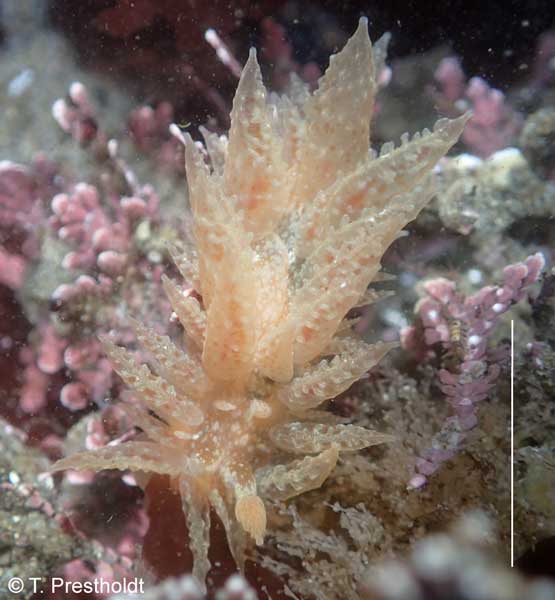
 both from Seal Rock, OR, intertidalDirona picta MacFarland, 1905Colorful Dironaintertidal to size to 30mm
both from Seal Rock, OR, intertidalDirona picta MacFarland, 1905Colorful Dironaintertidal to size to 30mm
northern Mexico to northern Oregon; Sea of Japan
This
species may be a wide range of colors. The body color ranges from
pink-orange to gray-green, with splotches of white to green and
pink-red spots.
Cumanotus fernaldi Thompson & Brown, 1984
Fernald's Aeolid
subtidal size to 18mm
southern California to southern BC
This species has very long cerata, as long as its body.
This page last revised: 7-2-2024
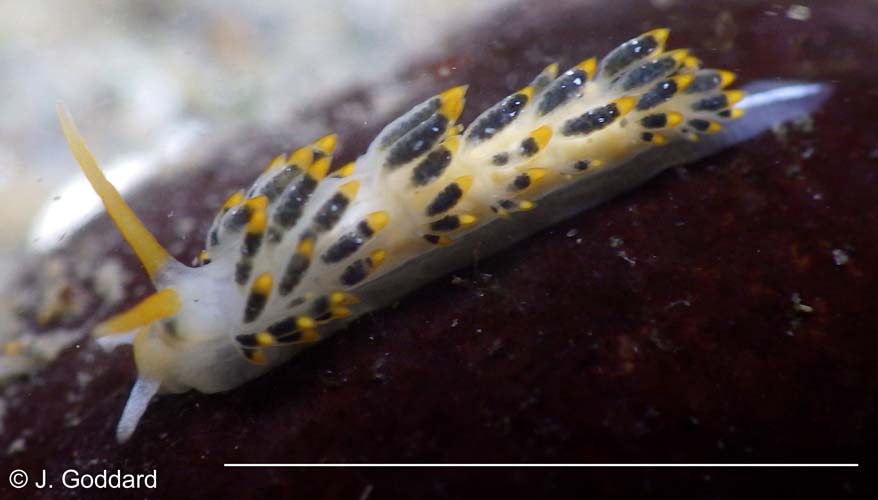 Drakes Estero, CA, intertidalDiaphoreolis lagunae (O'Donoghue, 1926)Laguna Beach Aeolid
Drakes Estero, CA, intertidalDiaphoreolis lagunae (O'Donoghue, 1926)Laguna Beach Aeolid
intertidal to shallow subtidal size to 14mmnorthern Mexico to southern Oregon
This species has a white body with dark cerata. The rhinophores, head and ceratal tips are yellow.
(previous names - Tenellia lagunae, Cuthona lagunae, Trinchesia lagunae, Cratena rutila)
Cumanotidae
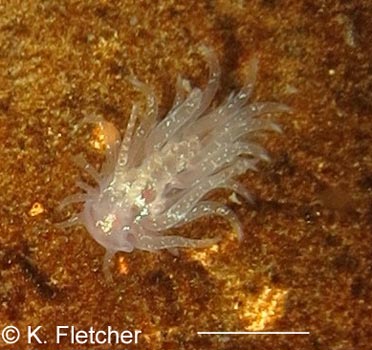
Illahee, WA, subtidal
Rich Passage,
WA, subtidal
 Egmont, BC, subtidal
Egmont, BC, subtidal
Cuthonella concinna (Alder & Hancock, 1843)Neat Aeolidsubtidal size to 15mmsouthern BC to northern Alaska; circumpolarThis is a very plain species
and may be cream to yellow.
(previous name - Cuthona concinna, Trinchesia concinna)
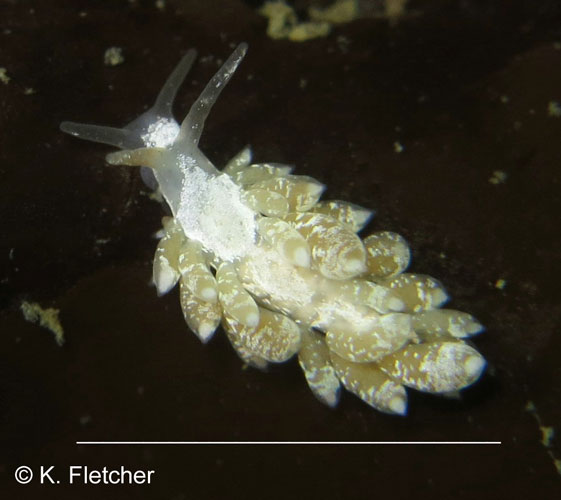
 Rich Passage, WA, subtidalTrinchesia albocrusta (MacFarland, 1996)White-crusted Aeolid
Rich Passage, WA, subtidalTrinchesia albocrusta (MacFarland, 1996)White-crusted Aeolid
intertidal to subtidal size to 12mm
northern Mexico to central Alaska
This
species is rare to find intertidally. It is identifiable by the
white encrustations on the cerata, head and rhinophores.
(previous name - Tenellia albocrusta, Cuthona albocrusta)
Catriona columbiana (O'Donoghue, 1922)
British Columbia Aeolid
intertidal to subtidal size to 20mm
southern California to southernmost Alaska; South Africa; New Zealand; Japan
This species is very infrequently seen intertidally. It feeds on the hydroid Tubularia.
The rhinophores are orange with a white tip. The cerata are
usually orange but may be brown and have a thick white stripe on the
outer side.
(synonyms - Tenellia columbiana, Cuthona columbiana, Catriona alpha, Cratena spadix)
 Pearse Islands, BC, subtidal
Pearse Islands, BC, subtidal
Cuthonella punicea (Millen, 1986)
Pomegranate Aeolid
subtidal northeast Vancouver Island, BC size to 20mm
The cerata are pomegranate red with white markings. It feeds on the equally red hydroid Zyzzyzus rubusidaeus which is visible in the photo.
(previous name - Cuthona punicea)
Cuthonidae
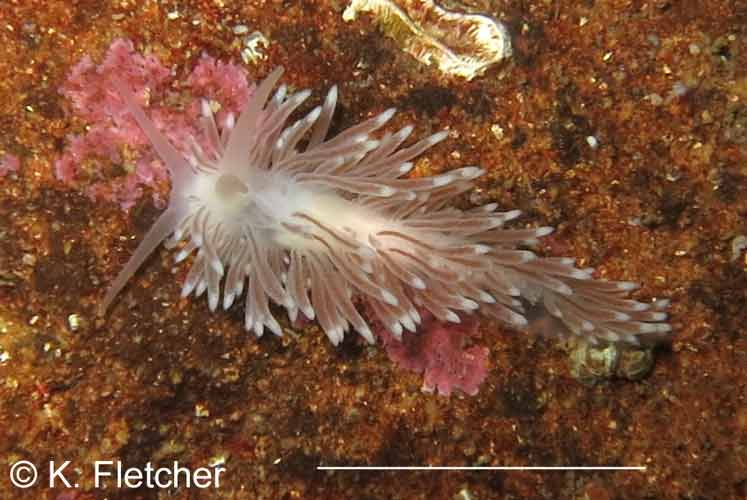
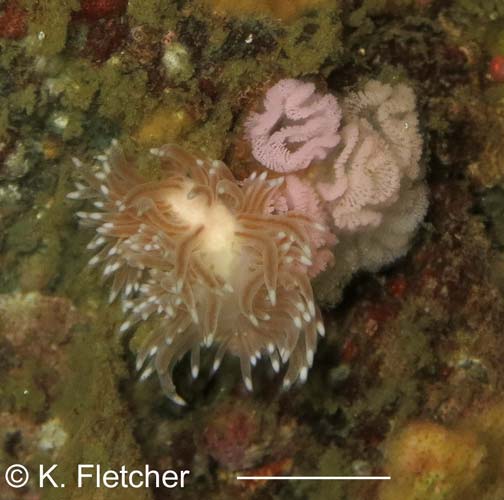
Rich Passage, WA, subtidal
Neah Bay, WA, subtidal, with eggs
Cuthona divae (Marcus, 1961)Rose-pink Cuthonaintertidal to 20m southern California to southern BC size to 34mmThis
is rarely found intertidally. The first 2-3 rows of cerata begin
in front of the rhinophores and are tipped in white. Its color may be cream to pink.(previous name - Precuthona divae, Cuthona rosea)
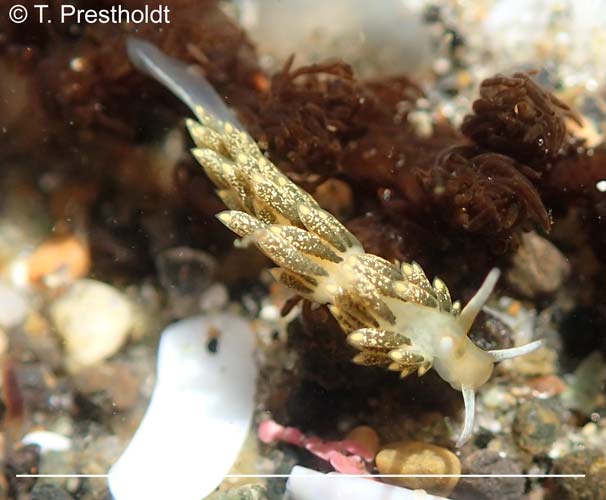 Strawberry Hill, OR, intertidalZelentia fulgens (MacFarland, 1966)Shiny Aeolidintertidal to shallow subtidal size to 8mm
Strawberry Hill, OR, intertidalZelentia fulgens (MacFarland, 1966)Shiny Aeolidintertidal to shallow subtidal size to 8mm
central California to northern Washington
This
species has a translucent body with white specks. The cerata have
a yellow band at the tip and the base with brown between.
(previous names - Tenellia fulgens, Cuthona fulgens, Cratena fulgens)
 Neah Bay, WA, subtidal
Neah Bay, WA, subtidal
Zelentia pustulata (Alder & Hancock, 1854)Pimpled Aeolidsubtidal to at least 15m size to 20mm
southern BC to central Alaska; north Atlantic south to Maine and France
This species has a translucent white body with reddish-brown cerata speckled with white.
(previous name - Cuthona pustulata, Trinchesia pustulata, Tenellia pustulata, Eolis pustulata)
Click on photo to enlarge. Scale line in photo equals 1cm unless otherwise specified.
* Species which are the most commonly encountered nudibranchs on the beach.
Those
in the order Nudibranchia are the true sea slugs. The adult forms
have a complete
absence of a shell and have externally exposed respiratory
organs.
Superfamily Fionoidea
Unidentiidae
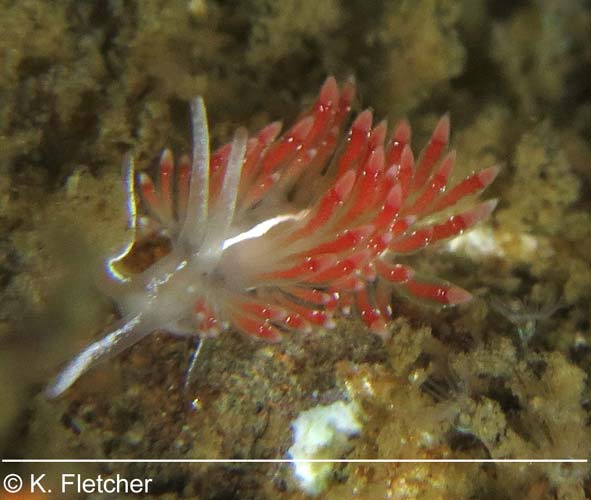
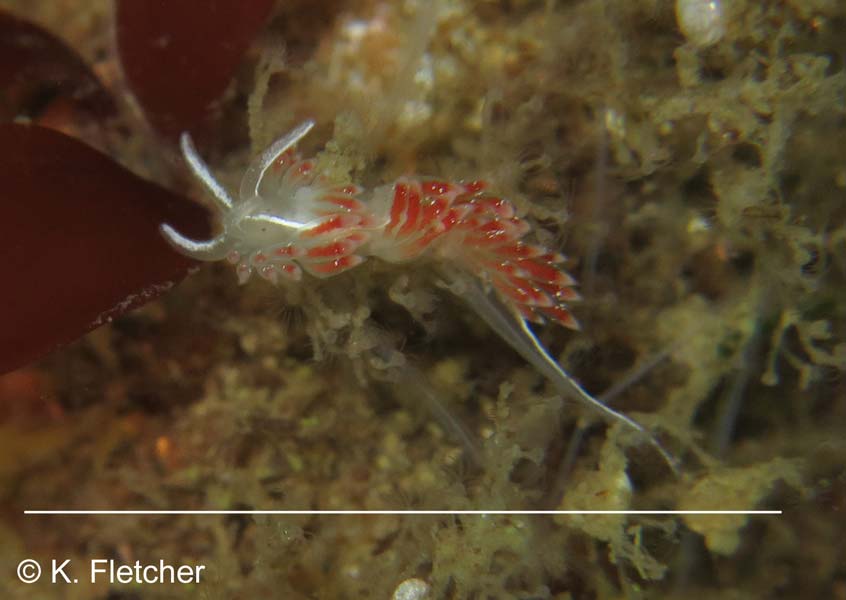 Rich Passage, WA, subtidalPacifia amica Korshunova, Martynov, Bakken, Evertsen, Fletcher, Mudianta, Saito, Lundin, Schrödl & Picton, 2017
Rich Passage, WA, subtidalPacifia amica Korshunova, Martynov, Bakken, Evertsen, Fletcher, Mudianta, Saito, Lundin, Schrödl & Picton, 2017
Red Sparkly Aeolid
subtidal to at least 15.2m size to 15mm
This
newly discovered species is known only from Rich Passage, just east of
Port Orchard, WA and the Pearse Islands, BC. It was found on stones with hydroids. It
is translucent white with opaque white lines on the body. The
cerata are orange-red to light pink with scattered small spots.
The ceratal tip is transparent. The rhinophores are smooth.
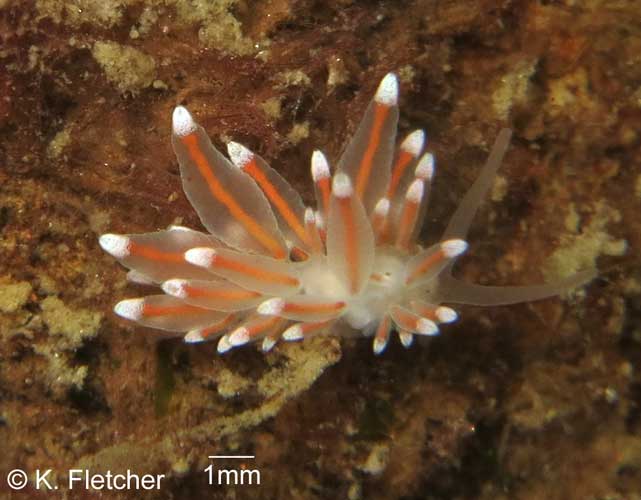
 Rich Passage, WA, subtidal Blakely Rock WA, subtidalEubranchus sanjuanensis Roller, 1972San Juan Aeolid
Rich Passage, WA, subtidal Blakely Rock WA, subtidalEubranchus sanjuanensis Roller, 1972San Juan Aeolid
subtidal to at least 20m size to 6mm
northern Washington to southeast Alaska
This tiny species is gray-white. The cerata cores are reddish to yellow.
Apata pricei (MacFarland, 1966)
Price's Aeolid
subtidal size to 25mm
southern California to southern Alaska
The
body is gray - white and a
white line on the tail divides along each side of its body, extending
about a third of the way up the body. The cerata are tipped with white, then a band of brown and the remainder is yellowish.
(previous name - Flabellina pricei, Coryphella pricei)
Eubranchidae Ladysmith, BC, subtidalEubranchus rupium (Moller, 1842)Rocky Aeolid or Green Balloon Aeolidsubtidal to 80m circumpolar size to 12mm
Ladysmith, BC, subtidalEubranchus rupium (Moller, 1842)Rocky Aeolid or Green Balloon Aeolidsubtidal to 80m circumpolar size to 12mm
This small species has a yellowish body and frosted white cerata with green cores. White flecks cover the body.
(previous name - Eubranchus olivaceus)
Ziminella japonica (Volodchenko, 1941)
Japanese Aeolid
subtidal Circumboreal size to 75mm
This species can be easily confused for the Shaggy Mouse nudibranch. In this species the cerata start behind the rhinophores. The color is cream to pink.
(synonyms - Flabellina japonica, Flabellina salmonacea, Coryphella salmonacea)
Paracoryphellidae
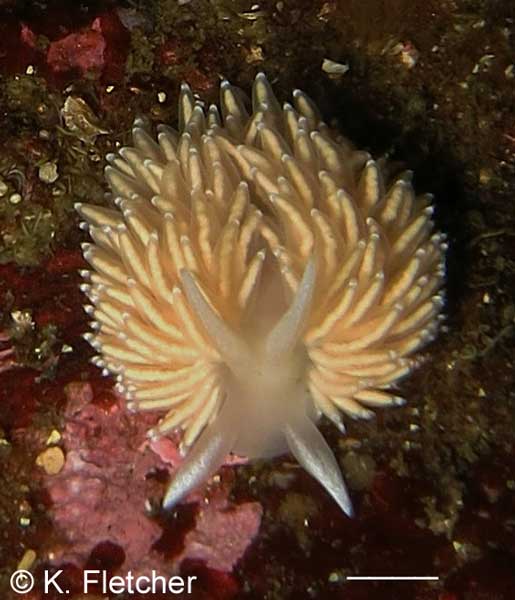 Hornby Island, BC, subtidal
Hornby Island, BC, subtidal
Apataidae


Low Point, WA, subtidal, with eggs
Port Orchard, WA, subtidal

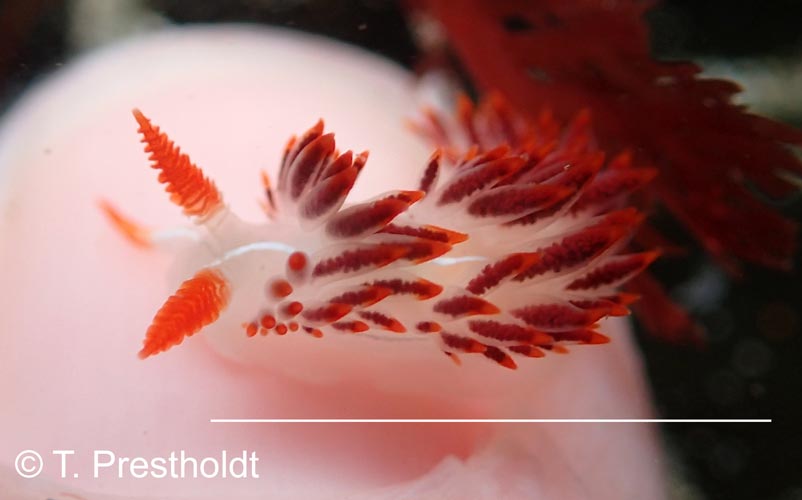 both are Strawberry Hill, OR, intertidal
both are Strawberry Hill, OR, intertidal
Coryphella trilineata (O'Donoghue, 1921)
Three-lined Aeolid
intertidal to 50m size to 36mm
northern Mexico to southern Alaska
This
is occasionally found intertidally. The body is white to gray and
has three opaque white lines extending down the body. The cerata
are orange to red and infrequently brown. They are tipped in white,
yellow or orange. The rhinophores are white with the upper portion
colored orange. We also see some with rhinophores which are
completely white.
(previous name - Flabellina trilineata, Orienthella trilineata)
Janolidae Slip Point, WA, intertidal Slip Point, WA,
intertidal Helby Island, WA, subtidal
Freshwater Bay, WA,
subtidal
Superfamily Tritonioidea
Superfamily Proctonotidae
Dironidae
Semiahmoo Spit, WA, intertidal
Marrowstone Point, WA, intertidal
Barkley
Sound, BC, subtidal
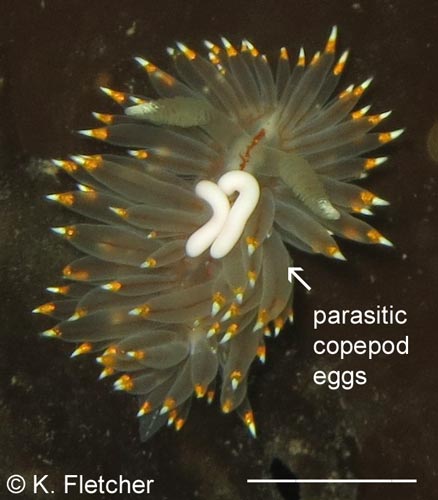 Rich Passage, WA, subtidal
Rich Passage, WA, subtidal
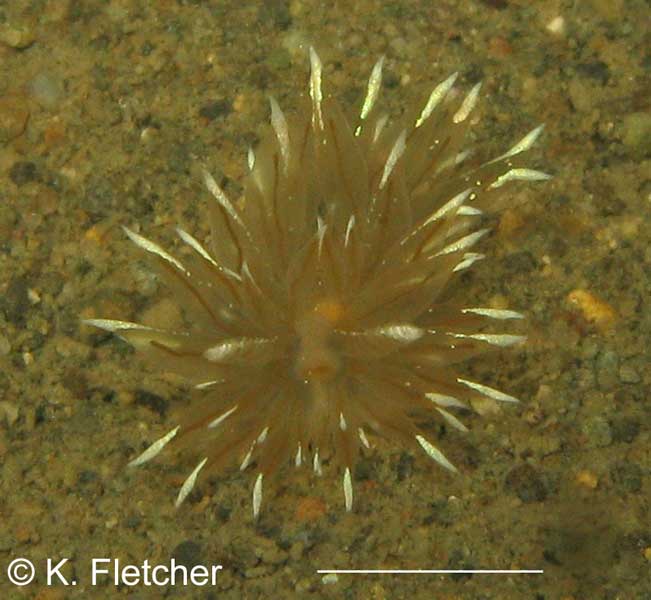 south Hood Canal, WA, subtidal
south Hood Canal, WA, subtidalAntiopella fusca (O'Donoghue, 1924)
White-and-Orange Tipped Nudibranch
intertidal to 30m size to 25mm
southern California to southern Alaska; Sea of Japan
This is occasionally found intertidally. It is easily identified by the orange and white tipped cerata.
(synonym - Janolus fuscus)
Antiopella gelidus (Millen, 2016)
subtidal, 17-37m southern BC to northern WA size to 23mm
The
body color on this species is translucent very pale to medium orange.
The rhinophores and papillae have white tips. They seem to prefer
silty sand and mud bottom. It is most likely to be confused with Dirona pellucida.
Tritoniidae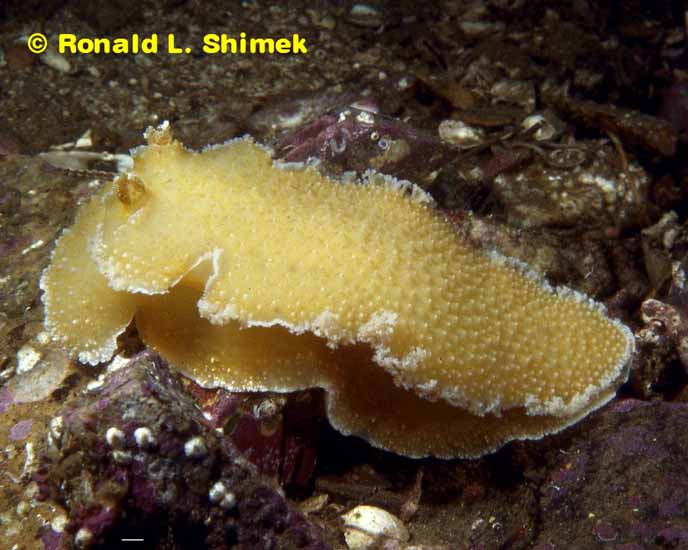
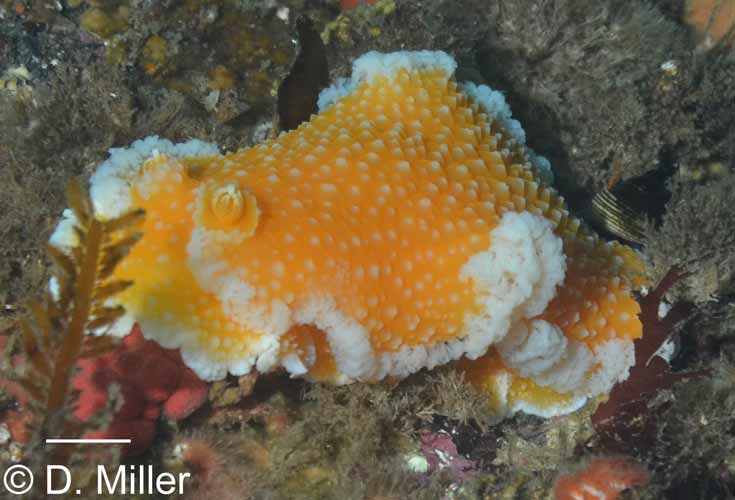
San Juan Islands, WA, subtidal
Neah Bay, WA, subtidal
Tochuina gigantea (Bergh, 1904)Orange-Peel Nudibranch
subtidal to 363m size to 50cm
southern California to northern Alaska, Siberia
This
species gets very large. The body is orange-yellow with a yellow
to pink foot. A white band rims the body. This species was
separated from Tochuina tetraquetra.
(previous names - Tritonia tetraquetra sensu Bergh, 1879, Limax tetraquetra, Tritonia gigantea)
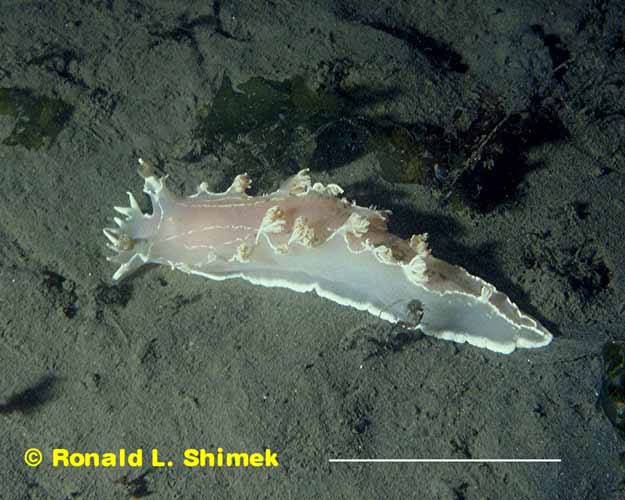
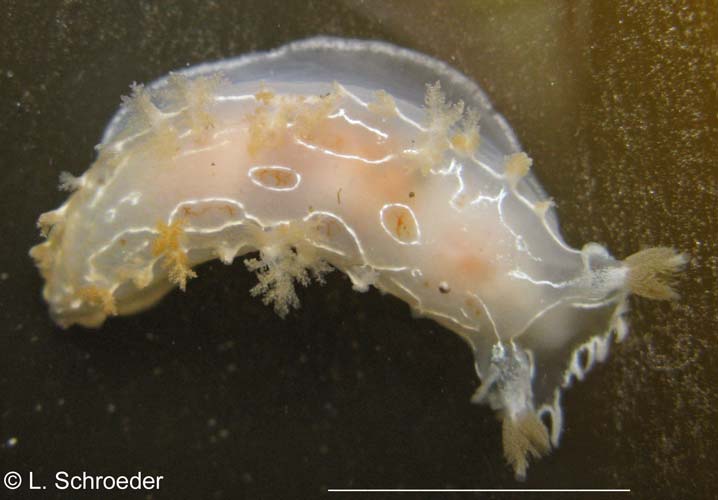 Friday Harbor, WA, subtidal
Cape Arago, OR, intertidalTritonia festiva (Stearns, 1873)Festive Tritonid or Diamondback Nudibranchintertidal to 50m size to 10cmnorthern Mexico to southern Alaska; JapanThis
is infrequently seen intertidally. It may be white to yellow to
brownish. The back is patterned with white lines.(previous name - Lateribranchiaea festiva)
Friday Harbor, WA, subtidal
Cape Arago, OR, intertidalTritonia festiva (Stearns, 1873)Festive Tritonid or Diamondback Nudibranchintertidal to 50m size to 10cmnorthern Mexico to southern Alaska; JapanThis
is infrequently seen intertidally. It may be white to yellow to
brownish. The back is patterned with white lines.(previous name - Lateribranchiaea festiva)

 Dash Point State Park, WA, subtidal Orcas Island, WA, subtidalTritonia exsulans Bergh, 1894Pink Tritoniaintertidal to 656m southern California to northern Alaska size to 22cm
Dash Point State Park, WA, subtidal Orcas Island, WA, subtidalTritonia exsulans Bergh, 1894Pink Tritoniaintertidal to 656m southern California to northern Alaska size to 22cm This
species is infrequently seen intertidally. It is pink to
reddish-salmon. A white band lines the foot and the lateral side
between the appendages. It likes
sandy bottoms and feeds on sea pens and sea whips. This was
recently separated from Tritonia tetraquetra, which does not have the lateral white lines between the appendages. T. exsulans is more common subtidally in the Pacific Northwest. T. tetraquetra is infrequently seen and is more common in colder northern waters. T. tetraquetra is also trans-Pacific.














